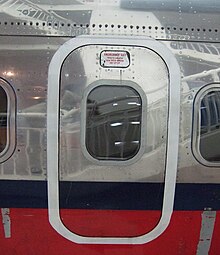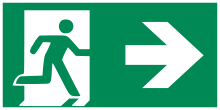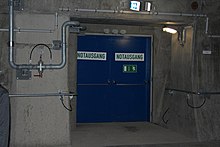Emergency exit


An emergency exit or emergency exit is an exit from a structure or vehicle / aircraft that is to be used in emergencies. In Germany, a distinction must be made here between exits on escape routes and emergency exits that are exclusively for use in an emergency. It is an essential part of the escape route provided for fire protection .
The size and number of emergency exits must be such that the people usually present in the building can flee outdoors as quickly as possible, even in the event of panic reactions , without the respective people falling and being overrun by those following or being harmed in any other way.
Regulations
Values and guidelines for emergency exits are specified in Germany in the workplace ordinance and the corresponding introductory decree. The implementation of emergency exits is also dealt with in ASR A 2.3.
Labelling
The emergency exit must be marked with a pictogram above the door, which is specified internationally in the DIN EN ISO 7010 standard . The marking is often done in combination with emergency lighting . It must be accessible at all times and must not be obstructed by objects. The way to the emergency exit (escape route) must also be clearly marked.
A disadvantage of the escape signs is that blind or visually impaired people usually cannot perceive them.
Doors and their locks
Depending on the application, an emergency exit door can only have door handles on the inside. In addition, the door fittings must be installed in such a way that the door can only be opened in the direction of escape. The door can have a lock , but it must be ensured that the door can be easily opened from the inside at any time, even when it is locked ( panic lock ).
For buildings in which panic is to be expected, for example because there are regularly many people who are unfamiliar with the location, the door must be equipped in accordance with the European standard EN 1125 (locks and building hardware - panic door locks with horizontal operating rod - requirements and test methods). This standard is not legally binding, however, as the Conference of Ministers of Construction established that equivalent closures can also be used. A DIN or EN standard is not a law and therefore cannot legally regulate that such door fittings must be used. Building law is responsible for such a binding regulation. Panic fittings that meet the requirements of the respective state building regulations are legally binding. As a rule, these are doors that can be easily opened to their full width with one movement.
See also
Web links
- DGUV Information 208-010: Locks for doors of emergency exits
- Door guard explained
- Technical article panic and emergency exit locks for doors appear in the FeuerTRUTZ magazine for fire protection planners in May 2017
Individual evidence
- ↑ ArbStättV - unofficial table of contents. In: www.gesetze-im-internet.de. Retrieved November 22, 2016 .
- ↑ Fire protection in operation: Correct behavior in the event of fire. Professional Association for Health Services and Welfare (BGW), accessed on December 15, 2018 .
- ↑ BAuA - ASR A2.3 Escape routes and emergency exits, escape and rescue plan / Technical rules for workplaces (ASR) / Workplace law / Workplaces / Topics from AZ / Federal Institute for Occupational Safety and Health. In: www.baua.de. Retrieved November 22, 2016 .
- ↑ Rettungsschilder.eu: Emergency exit sign . Explanation of the emergency exit sign (accessed April 7, 2014).



